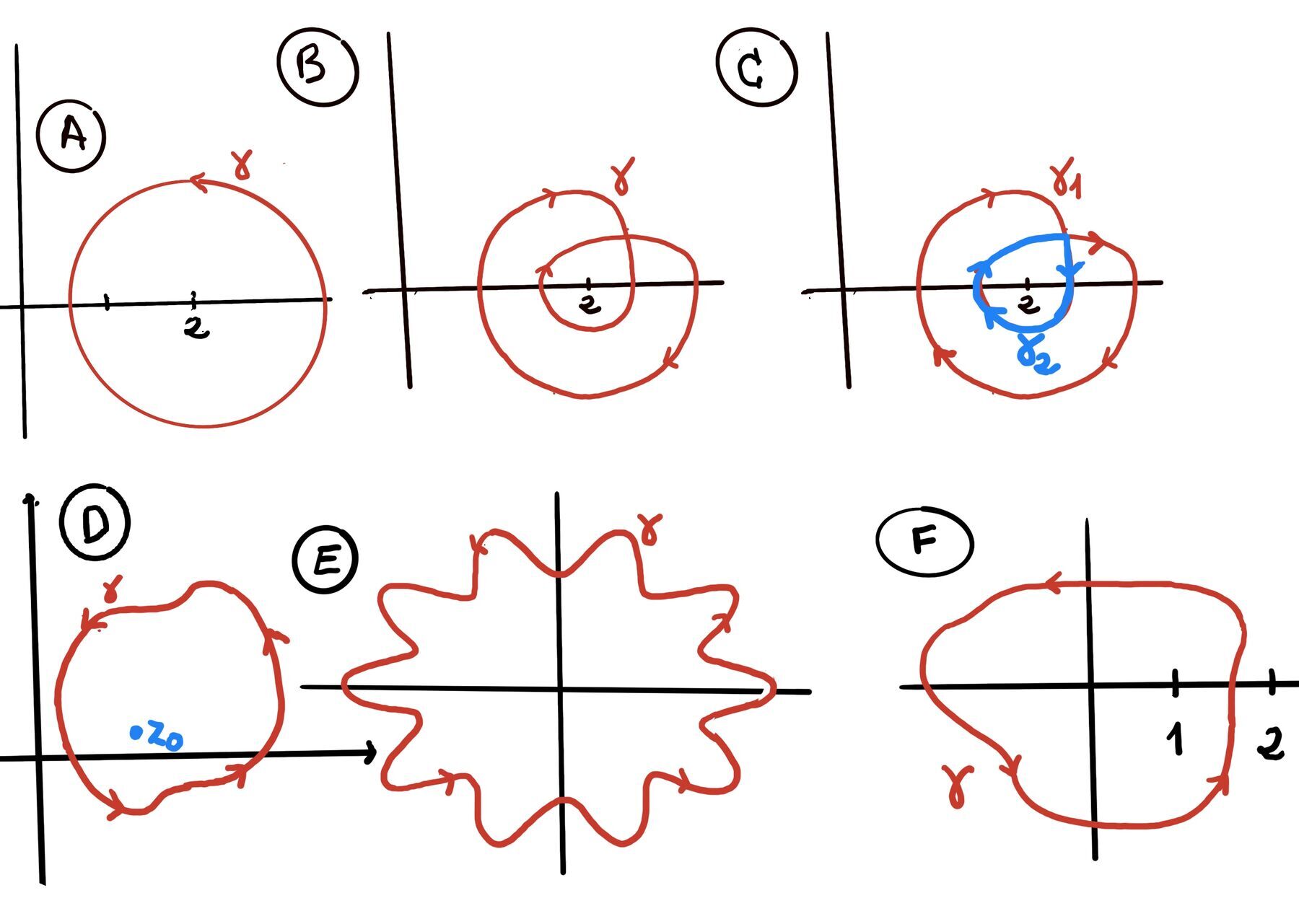
|
 |
 |
You can only grow if you’re willing to feel awkward and uncomfortable when you try something new, Brian Tracy

A complex function $f(z)$ maps $z = x + iy \in \mathbb{C}$ to another complex number. For example: $f(z) = z^2 = (x + iy)^2 = x^2 - y^2 + 2ixy, f(z) = \frac{1}{z}, f(z) = \sqrt{z^2 + 7}$.
A contour is a continuous, piecewise-smooth curve defined parametrically as: $z(t) = x(t) + iy(t), \quad a \leq t \leq b$.
Definition (Smooth Contour Integral). Let ᵞ be a smooth contour (a continuously differentiable path in the complex plane), $\gamma: [a, b] \to \mathbb{C}$. Let $f: \gamma^* \to \mathbb{C}$ be a continuous complex-valued function defined on the trace $\gamma^*$ of the contour (i.e. along the image of $\gamma$). Then, the contour integral of f along $\gamma$ is defined as $\int_{\gamma} f(z)dz := \int_{a}^{b} f(\gamma(t)) \gamma^{'}(t)dt$.

Deformation of Contours. If two contours $\gamma_1$ and $\gamma_2 $ are homotopic (i.e., one can be continuously deformed into the other without crossing any singularities of f) in a domain where f(z) is analytic, then: $\int_{\gamma_1} f(z)dz = \int_{\gamma_2} f(z)dz.$
Fundamental Theorem of Calculus for Contours. Suppose $\gamma$ is a contour (piecewise smooth path) from a to b, f is defined on a domain D containing $\gamma^*$ (the image of $\gamma$) and admits a primitive (antiderivative) F on D (i.e., $F'(z) = f(z)$), then $\int_{\gamma} f(z)dz = F(\gamma(b)) - F(\gamma(a))$. In particular, if $\gamma$ is a closed contour (i.e., $\gamma(a)=\gamma(b)$), this integral evaluates to zero, $\int_{\gamma} f(z)dz = 0.$
Estimation Theorem or the Triangle Inequality for Integrals. The triangle inequality for integrals in complex analysis states thatfor any continuous complex function $f:[a,b] \to \mathbb{C}$ on a closed real interval [a,b] (f(t) = u(t) + iv(t), t a real parameter), the following holds: $∣\int_a^b f(t)dt| \leq \int_a^b |f(t)|dt$.
Estimation Lemma (ML Inequality) for contour integrals. For any continuous complex function $f:[a,b] \to \mathbb{C}$ on a closed real interval [a,b] (f(z) = u(x, y) + iv(x, y)) with f bounded by some constant M along the entire contour, |f(z)| ≤ M for all $z \in \gamma^*$ (the image/trace of the contour in the complex plane), the following holds: $∣\int_\gamma f(z)dz| \leq M \cdot l(\gamma)$ where l(γ) is the arc length of the contour γ given by $\int_a^b |\gamma^{'}(t)|dt = \int_a^b \sqrt{x'(t)^2 + y'(t)^2} \text{ where } \gamma(t) = x(t) + iy(t)$.
In the plane, closed loops that don’t cross themselves behave like “boundaries.” Jordan’s curve theorem makes this precise: every such loop splits the plane into an “inside” and an “outside,” and the loop is the common boundary. This simple-looking fact is surprisingly deep; its full proof is non-trivial and sits at the foundation of topology and complex analysis.
Definition. A simple closed curve (Jordan curve) is a continuous loop that does not intersect itself and starts and ends at the same point.
Alternative definition. A map $\gamma:[a,b]\to\mathbb{R}^2$ (or ($\mathbb{C})$) is a simple closed curve if:
Simple closed curves: circles, ellipses, polygons (triangle, square, arbitrary simple polygon), and wiggly non-self-intersecting loops.
Not a simple closed curve: A figure-eight, curve with a cusp that crosses itself (it is not a simple closed curve due to self-intersection; it consists of two separate loops) or any open curve (e.g., a segment, a ray) — these fail injectivity on [a,b) or fail to be closed.
 Figure 1 (left block): examples of simple closed curves. Figure 2 (right block): not simple.
Figure 1 (left block): examples of simple closed curves. Figure 2 (right block): not simple.
Definition. A region or set $U\subset\mathbb{C}$ is connected if any two points of U can be joined by a continuous path lying entirely in the region or set U.
A domain D is simply connected if it is connected and every closed loop in D can be continuously shrunk to a point inside D.
Jordan’s curve theorem. Any simple closed curve (a continuous loop in the plane that does not intersect itself) separates the plane into two components or disjoint connected regions: one interior (bounded) and one exterior (unbounded). The curve itself is the boundary of both regions. In other words, it partitions the plane into exactly three disjoint sets:
The Jordan’s curve theorem leads directly to several critical concepts:
Example. Let $\gamma: [0, 2\pi] \to \mathbb{C}$ be defined as $\gamma(t) = \cos(t) + i\sin(t), 0 \le t \le 2\pi$. This parameterization describes the unit circle in the complex plane. The interior of the curve, denoted as $\mathcal{Int}(\gamma)$, is given by $\mathcal{Int}(\gamma) = \{ z: |z| \lt 1 \}$ which represents all complex numbers whose magnitudes are less than 1.Conversely, the exterior of the curve, denoted as $\mathcal{Ext}(\gamma)$, is defined as $\mathcal{Ext}(\gamma) = \{ z: |z| \gt 1 \}$ encompassing all complex numbers with magnitudes greater than 1.
Definition. A simple closed contour γ is positively orientated if, as you traverse it, the bounded interior region (Int(γ)) is always to (stays on or appears to) your left (tracing the curve counterclockwise places the interior on the left). Conversely, it is negatively orientated if the interior is to your right (Figure 3).
Imagine walking along a circular path. If you are walking counterclockwise and the garden (the interior) is on your left, you are positively oriented. If the garden is on your right, you are walking clockwise (negatively oriented).
Definition. For a positively oriented contour, the “inside” is the bounded component (Int(γ)). For a negatively oriented contour, the “inside” is the unbounded component (Ext(γ)).
However, in most practical applications, especially in complex analysis (e.g., Cauchy’s Integral Theorem), we standardize our curves to be positively oriented. Therefore, unless stated otherwise, “the inside of a simple closed contour” universally refers to the bounded region.
